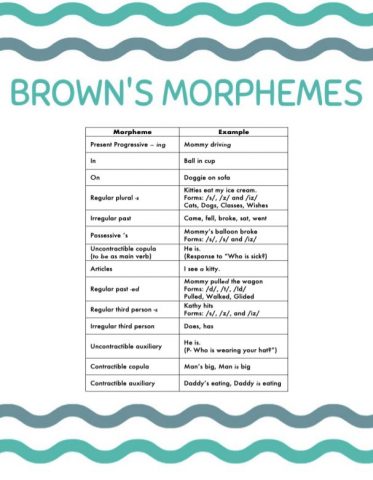Grammar is the rules or structure of a given language. It is the rules for how words, phrases, and sentences go together. These rules are not all the same in each language, but every language has grammar. Examples of English grammar rules that occur at the:
- Word level include regular plurals (e.g., cats) vs irregular plural (e.g. mice), or verb endings (e.g. walking, walked)
- Phrase level include putting adjectives before the word it is describing (e.g., blue hat is correct in English, but hat blue is not)
- Sentence level include using subject-verb-object order to make a statement (e.g., The dog chases the ball.)
Generally, as a child’s expressive phrase/sentence increases, their ability to use new grammatical structures also improves. These structures increase in complexity over time and are separated into stages, known as “Brown’s Stages” or “Brown’s Morphemes.” Below is a chart outlining these stages.
Grammar can be worked on throughout the day during many activities of daily living. Here are some general tips and activities that can help develop your child’s grammar skills in any language you can best model for them:
- Expand on what your child has said without adding new information to let them know that you have heard and understood them. For example, if they say “Truck go.” You can expand on it by saying “The truck is going.”
- Extend your child’s utterances by making them more complex and adding more information to provide them a model for future utterances. For example, if they say ““Truck go.” You can expand on it by saying “The truck is going. It is a big truck.”
- Model and repeat good language after your child has made a mistake. For example, if your child says “Look, mouses!” You can say, “Yes I see the mice. There are two mice. The mice are running away from the cat.” You may like to slightly emphasize the correct word to use.
- Narrate what you are doing throughout the day. Talk out loud like you are sports announcer. Talk about what you are doing as you are doing it, to provide models of a variety of sentences for your child and so they can make associations of actions to words. For example, “I am feeling thirsty. I am going to get a drink. Where are the cups? Here is a big cup. The cup is empty and now it is full.”
- Read Books that repeat the grammar target multiple times or opportunities to emphasize the target throughout the book by going off the script. Books are great for targeting different verb tenses, and pronouns such as he, she, and they.
Additional resources/activities for different areas of grammar:
Pronouns (he/she/they)
Verb tense (present/past/future)
Present progressive tense (-ing) activity
3rd Person Singular Verbs Activity
Regular past tense verbs bingo
Plurals
Regular plural nouns matching game
Irregular plural nouns matching game
Irregular plural nouns flip book
Conjunctions (and, because, so)
What are conjunctions and activities to teach them
Conjunctions hands on activity
Other useful resources and websites
Grammar resource page from Speech and Language Kids
The Hanen Centre – How to help your child use early sentences
